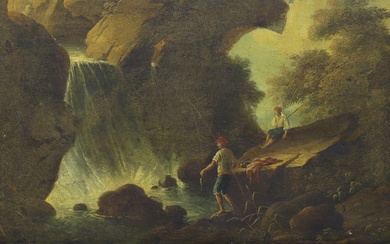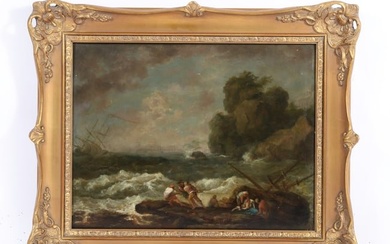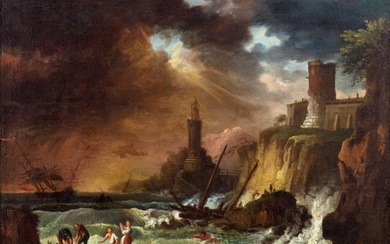French school of the late 18th century. Circle of CLAUDE JOSEPH VERNET (Avignon, 1714 -...
French school of the late 18th century. Circle of CLAUDE JOSEPH VERNET (Avignon, 1714 - Paris, 1789). "Landscape with fishermen. Oil on canvas. Re-coloured. Size: 120 x 175 cm; 133 x 192 cm (frame).
French school of the late 18th century. Circle of CLAUDE JOSEPH VERNET (Avignon, 1714 - Paris, 1789).
"Landscape with fishermen.
Oil on canvas. Re-coloured.
Size: 120 x 175 cm; 133 x 192 cm (frame).
The present canvas, painted by an artist of Claude Joseph Vernet's circle, offers us a spectacular river landscape full of fishermen, with a scenographic composition captured from a high point of view that allows a detailed view of the different planes. They follow one another in depth, marking a dynamic zigzag that avoids compositional monotony, with light and shadow alternating in a very effective way, in keeping with the scenographic conception of nature.
One of the most radical aspects of Romantic painting was the attempt to replace large canvases with historical or religious themes with landscapes. They wanted the pure landscape, almost without figures or totally devoid of them, to attain the heroic significance of history painting. They were based on the idea that human feeling and nature should be complementary, one reflected in the other. In other words, landscape should arouse emotion and convey ideas. Thus, landscape painters such as the author of this canvas tried to express their feelings through the landscape, rather than imitating it. The Romantic landscape had two main strands: the dramatic, with its turbulent and fantastic views, and the naturalistic, which emphasised images of peaceful and serene nature.
From the cave paintings until the 18th century, nature rarely appeared in pictorial works as a valuable landscape in its own right. Chinese artists, from the 5th century onwards, are credited with 'discovering' landscape as a pictorial element, influenced by Buddhism and its conception of nature. In Europe, however, it was not until the Renaissance that landscape came to the fore, gradually increasing its presence in works of art and becoming an object of interest in its own right rather than as a background for a religious composition or a portrait. But it did not gain the status of a pictorial genre until the 17th century in Holland, a country that developed an important landscape school. In the 19th century, the Dutch example became universal, becoming one of the objectives of pictorial realism, especially in France through the Barbizon School and Plenilirism. This new interest in capturing a fleeting moment of light or an anecdote in the midst of nature led to the use of techniques such as watercolour, which was quicker to execute, and loose brushstrokes in an attempt to achieve an impression rather than a drawing, one of the keys to Impressionism.
View it on
Estimate
Time, Location
Auction House
French school of the late 18th century. Circle of CLAUDE JOSEPH VERNET (Avignon, 1714 - Paris, 1789). "Landscape with fishermen. Oil on canvas. Re-coloured. Size: 120 x 175 cm; 133 x 192 cm (frame).
French school of the late 18th century. Circle of CLAUDE JOSEPH VERNET (Avignon, 1714 - Paris, 1789).
"Landscape with fishermen.
Oil on canvas. Re-coloured.
Size: 120 x 175 cm; 133 x 192 cm (frame).
The present canvas, painted by an artist of Claude Joseph Vernet's circle, offers us a spectacular river landscape full of fishermen, with a scenographic composition captured from a high point of view that allows a detailed view of the different planes. They follow one another in depth, marking a dynamic zigzag that avoids compositional monotony, with light and shadow alternating in a very effective way, in keeping with the scenographic conception of nature.
One of the most radical aspects of Romantic painting was the attempt to replace large canvases with historical or religious themes with landscapes. They wanted the pure landscape, almost without figures or totally devoid of them, to attain the heroic significance of history painting. They were based on the idea that human feeling and nature should be complementary, one reflected in the other. In other words, landscape should arouse emotion and convey ideas. Thus, landscape painters such as the author of this canvas tried to express their feelings through the landscape, rather than imitating it. The Romantic landscape had two main strands: the dramatic, with its turbulent and fantastic views, and the naturalistic, which emphasised images of peaceful and serene nature.
From the cave paintings until the 18th century, nature rarely appeared in pictorial works as a valuable landscape in its own right. Chinese artists, from the 5th century onwards, are credited with 'discovering' landscape as a pictorial element, influenced by Buddhism and its conception of nature. In Europe, however, it was not until the Renaissance that landscape came to the fore, gradually increasing its presence in works of art and becoming an object of interest in its own right rather than as a background for a religious composition or a portrait. But it did not gain the status of a pictorial genre until the 17th century in Holland, a country that developed an important landscape school. In the 19th century, the Dutch example became universal, becoming one of the objectives of pictorial realism, especially in France through the Barbizon School and Plenilirism. This new interest in capturing a fleeting moment of light or an anecdote in the midst of nature led to the use of techniques such as watercolour, which was quicker to execute, and loose brushstrokes in an attempt to achieve an impression rather than a drawing, one of the keys to Impressionism.







